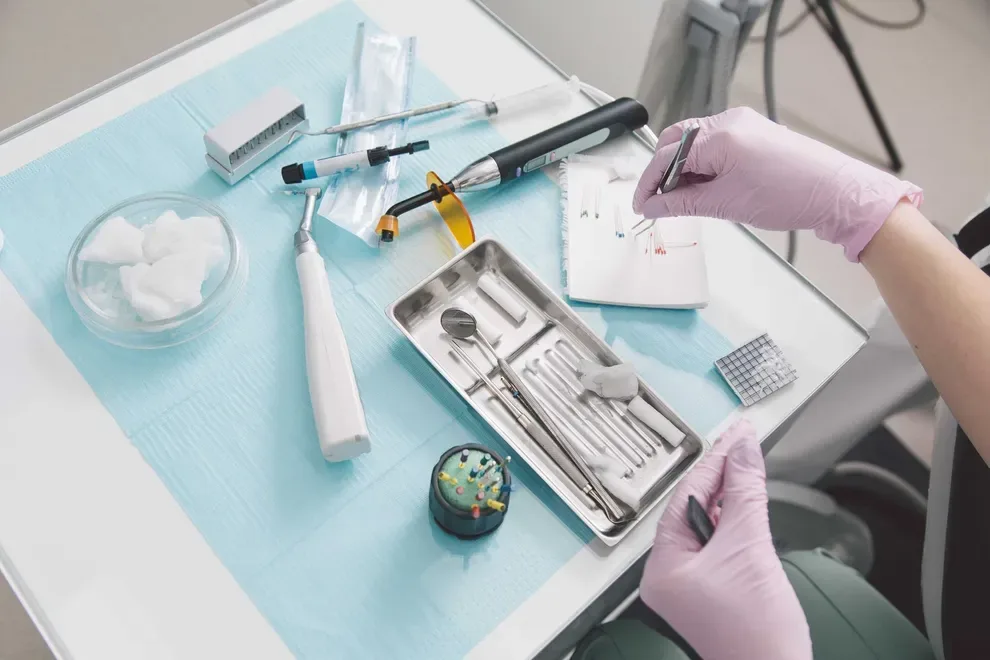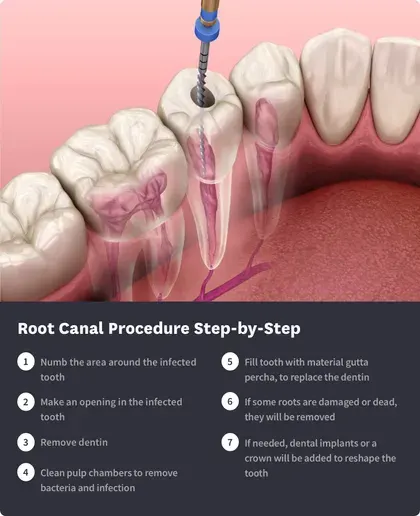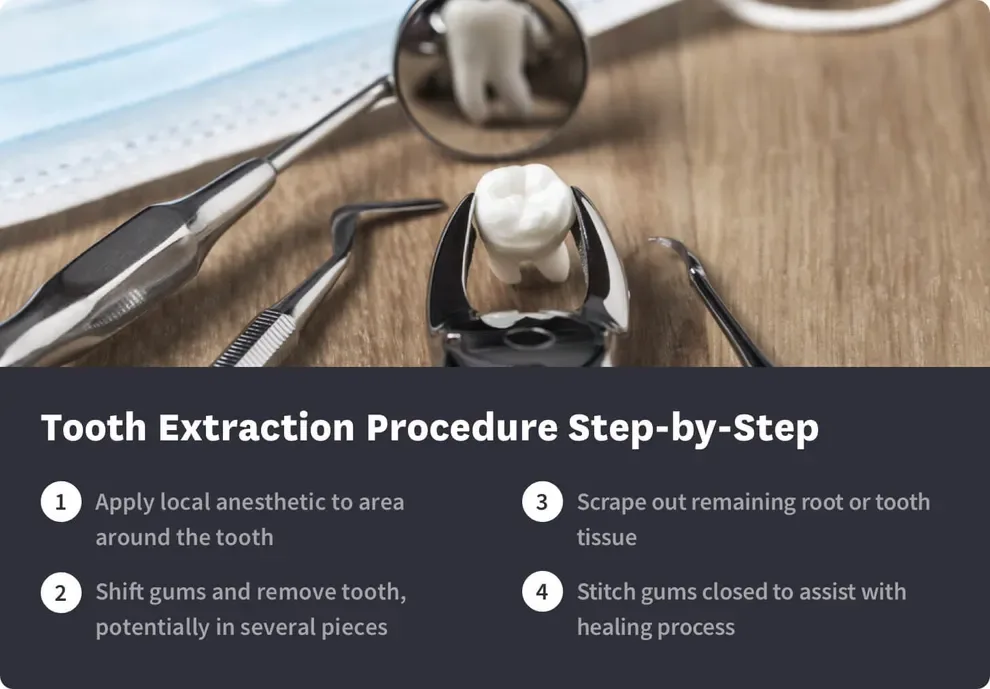Root Canal vs. Extraction: Comparing Pain, Cost & Recovery

Table of Contents
- Surgical Treatment
- Root Canal Specifics
- Root Canals Over Extractions
- Cost of Root Canal
- Tooth Extraction Specifics
- Cost of Dental Extractions
- Necessity of Root Canals & Extractions
- Root Canal or Extraction?
- Frequently Asked Questions
Both root canals and surgical tooth extractions are common medical procedures in the United States. A root canal removes bacteria from an infected tooth, essentially replacing part or all of the root with a type of filling. An extraction involves removing the tooth altogether.
The cost of a root canal varies from $600 to $1,400 on average. The cost of a tooth extraction usually ranges from $130 to $500.
This chart can help you understand the differences between these procedures.
| What Happens? | Recovery Time | Risks | Costs |
Root canal | Infected pulp is removed, the tooth’s insides are cleaned, and the hole is filled | Less than 24 hours | Infection, inadequate filling, improper sealant, and missed canals | $600-$1,400 |
Extraction | The damaged tooth is pulled from your mouth | 48 hours or longer | Improper alignment, bite collapse, dry socket, and nerve injury | $130-$500, with additional expenses for artificial tooth replacement |
Surgical Treatment to Promote Good Oral Health
Thanks to several medical advances, more people than ever before are able to maintain good oral health and keep the majority of their natural teeth through their lifetimes. However, even people who maintain overall good oral health may need surgical dental treatment, which can include a root canal or a tooth extraction.
Thousands of adults in the United States are more prone to periodontal disease due to genetics, underlying conditions, misaligned teeth, or other causes. This can increase the risk of more serious oral health problems, including periodontal infection severe enough to require a root canal or removing the tooth. Both of these procedures are outpatient surgeries, with a few weeks’ recovery time, and prescription medicines like painkillers or antibiotics.
Dentists are most likely to recommend treatment that provides the best health outcomes, which typically involves keeping as much of the tooth as possible – so, you are more likely to have a root canal recommended than a tooth extraction. However, your dentist may recommend an extraction for different reasons, or offer you the option of a root canal vs. an extraction. Here are some important points for comparison between the two procedures, so you can understand them.
Root Canal Specifics

A root canal is a procedure designed to eliminate bacteria from an infected root of the tooth, save as much of the tooth tissue as possible, and prevent reinfection of the tooth or surrounding teeth. The basic procedure during a root canal involves removing infected pulp, or dentin, from inside the tooth, cleaning and disinfecting the inside to save as much of the tooth’s roots as possible, and then filling the tooth. Your dentist may need to add dental implants to stabilize the filling or cover the tooth with a crown to reshape it. However, this is not always necessary.
The basic steps of a root canal are:
Your dentist will numb the area around the infected tooth.
They will make an opening in the infected tooth to reach the dentin.
Once the dentin has been removed, the pulp chambers will be fully cleaned to remove any excess bacteria or pockets of infection.
Your dentist will fill the tooth with a material called gutta percha, a special type of filling specifically to replace dentin.
If some roots are damaged or dead, your dentist may remove them.
If your tooth needs more structure, you may receive dental implants for a later dental crown to reshape the tooth.
Once this treatment is complete, your dentist will schedule any necessary follow-up appointments, including a second root canal procedure to complete cleaning and tooth shaping, a procedure to fit you for a crown, and a simple check-up to ensure your tooth is healing.
Potential Risks
If your endodontist can perform a root canal on your tooth rather than removing the entire tooth, they will recommend this option. It is healthier for your teeth overall to leave as much of a natural tooth as possible in place, even when this requires extensive treatment like a root canal.
Root canals are surgical procedures, so there can be complications during the healing process or that are caused by the root canal itself.
Root canals require removing parts of the tooth and replacing the dentin, or the soft inner tissues in the tooth. They also require removing some of that tooth’s roots. Removing this much tissue creates places for bacteria to collect and thrive, so it is important to follow your endodontist’s instructions after a root canal to keep your teeth and mouth clean, reducing the risk of infection.
If you develop an infection after the root canal, which can be painful, cause your mouth or face to feel warm, lead to bleeding, or cause other problems, contact your endodontist for immediate treatment.
Your endodontist will use filling to create a shape like your original tooth, but it is possible that they might underfill or overfill the area. This means that your bite will not fit together as it did before, which can cause stress on your other teeth, leading to pain, chips, or cracks in your enamel, and alignment problems.
Once your dentist has completed the root canal, they will seal the tooth to protect it from further harm. If the seal does not work well or set properly, this can lead to damage to the existing tooth and the filling, and cause an infection.
If your dentist misses a damaged root and fails to replace it with an artificial canal, this increases the risk of later dental problems. They may need to redo the root canal or extract the tooth despite the root canal.
It is important to know that these are uncommon risks associated with root canals. This procedure has existed for more than a century, has been thoroughly studied, and is the best option for most people.
In some cases, your endodontist will recommend a tooth extraction instead or as a cheaper option compared to a root canal, but there are more serious risks associated with extraction.
Why Root Canals Are Chosen Over Extractions
Endodontists recommend root canals over extractions in most cases because:
Maintaining as much of the tooth as possible allows for better natural fit for your teeth, keeping your chewing action and jaw muscles healthy.
Root canals maintain the natural appearance of teeth.
Root canals protect other teeth from excessive wear and tear due to bite changes.
Although you may worry about your long-term oral health if the dentin is removed from inside your tooth, endodontists agree that adult teeth can survive as long as an internal support structure, like a filling, is placed where the dentin used to be. Root canals are relatively painless, thanks to local anesthetics, require only one or two treatments, and restore most functionality to the individual tooth and your teeth overall, without disrupting your bite or smile.
Root canals are fairly quick, outpatient surgical procedures. Most people need only local anesthesia, which will keep your mouth numb for between two and four hours after the procedure. It is possible you may be a little tired the next day, but you should be able to return to work, school, or family responsibilities.
Patients may experience some pain in recovery from both root canals and extractions, but discomfort can generally be managed with over-the-counter pain relievers.
Cost of Root Canal
You may worry about the cost of a surgical procedure like a root canal. Rest assured that your dental insurance should cover part of the cost of a root canal, although they will also cover some of the cost of a tooth extraction if your dentist deems it medically necessary.
Cost can vary based on which tooth requires a root canal:
Front tooth: $600 to $900
Bicuspid tooth: $700 to $1,000
Molar tooth: $1,000 to $1,400
Other fees associated with a root canal can include the following:
Diagnostic x-rays: These can cost between $25 and $250, depending on the technology used.
Crowns: A dental crown could be required if your root canal leaves your tooth fragile. These devices can cost between $1,000 and $1,500.
Follow-up visit: Your dentist may want to see you again after the procedure and ensure you’re healing well. This visit could cost around $100.
Dental insurance plans can help you cover the cost of a root canal, but understanding the specifics is critical. Some dental plans only cover preventive care (such as cleanings and routine x-rays) at 100%, while paying just 80% of basic care (such as root canals). If you need a crown after your root canal, that could be considered major care, covered at only 50%.
Tooth Extraction Specifics

A tooth extraction may sound simpler than a root canal. Rather than cleaning and re-sculpting a damaged tooth, why not simply remove it? This was the standard practice in dentistry for centuries, but since the late 20th century, medical advances in dentistry have allowed most patients to retain the basic structure of their teeth through a root canal.
However, there are several cases when a surgical tooth extraction is a better solution than a root canal. For example, if your teeth are crowded, your dentist may remove a tooth to make room for dental prosthetics or braces. The vast majority of Americans have their wisdom teeth removed, so it is likely that you have already experienced a type of surgical extraction for both health and cosmetic purposes.
You or your dentist may opt to remove a tooth because of:
Extensive cavities.
Gum disease.
Advanced periodontal infections.
Trauma or injury to the tooth and/or the surrounding bone.
Since a tooth extraction is typically associated with periodontal disease, your dentist will likely clean your teeth right before the procedure and prescribe antibiotics to ensure you have an overall healthy mouth. On the day of the procedure, your dentist will:
Apply local anesthetic to the area around the damaged tooth.
Give you a mild sedative if you have dental anxiety.
Shift the gums and begin removing the tooth, potentially in several pieces.
Scrape any remaining root or tooth tissue out of the area.
Stitch the gums closed to assist the healing process.
When you return home after the procedure, you may need to change the gauze in your mouth several times. This may last for one or two days after the procedure, but you should notice a significant drop in bleeding as the wound closes after the first day. You may receive a prescription for painkillers, but your dentist will likely recommend focusing on over-the-counter options like ibuprofen or acetaminophen since these can control inflammation as well as pain.
You will also need to avoid certain foods for the first few days after the extraction, particularly crunchy foods or drinks you need to suck through a straw. Avoid smoking, drinking alcohol, or using mouthwashes containing alcohol. Continue to brush and floss, but be gentle around the extraction site to promote healing.
Potential Risks
Postsurgical problems from tooth extractions are similar to those of root canals, especially the increased risk of infection. There is also a risk that your gums will not heal properly or quickly, which can cause pain.
There are some other risks associated with tooth extractions that can damage your oral health long term, particularly if you do not get a dental implant to replace the missing tooth.
When you remove a whole tooth, including the roots, there is a space in your jaw. Putting a dental implant in its place can help to reduce problems with teeth shifting, but they are at risk of shifting regardless, with worse outcomes for those who do not get implants. This means your teeth are at risk of becoming misaligned, increasing the risk of dental hygiene problems, and needing another tooth extraction.
This is more likely if you have had back teeth removed, as your bite can cause your jaw to shift in alignment related to your top teeth. This increases strain on your teeth as well as your jaw muscles, which can cause pain and damage. It also increases the risk of dry, chapped, or cracked lips.
Your dentist may have warned you about dry socket risks when you had your wisdom teeth removed. There is a similar risk for people who have other teeth removed. Additionally, tooth removal may cause damage to nerves in the jaw, decreasing sensation and increasing the risk of accidental damage.
It is generally preferable for your overall oral health for your dentist or endodontist to perform a root canal rather than removing your entire tooth. But sometimes, there is not enough of your natural tooth left after a serious infection. In this case, be sure to follow up with your endodontist after healing so you can get a dental implant to replace your natural tooth and reduce the risk of the above long-term health problems.
Cost of Dental Extractions
Dental extractions can vary in cost, but if your dentist deems it medically necessary, then your insurance should help cover the cost.
A simple routine extraction may cost as little as $130; an extraction requiring the removal of gum or bone tissue may cost as much as $370; and wisdom tooth removal may cost about $500 for the procedure, not including the cost of anesthetic.
Other fees potentially associated with an extraction include the following:
Diagnostic x-rays: These can cost between $25 and $250, depending on the technology used.
Prescriptions: If your doctor recommends painkillers and antibiotics after the procedure, you may be faced with fees to fill them.
Implants: Your dentist may recommend an implant to fill the gap left behind by your missing teeth. These can cost more than $4,000.
Dental insurance plans can help you cover these fees, but your out-of-pocket expenses can vary. Your plan may only pay 80% of the fees involved with your extraction, and only 50% of your implant.
The Necessity of Root Canals & Extractions
While few people enjoy the idea of getting a root canal or extraction, handling these significant dental problems is a smart step.
Root canals are required when the pulp inside of your tooth becomes inflamed or infected. Leaving these problems untreated can lead to intense pain or an abscess. A dental abscess is a pocket of pus that doesn’t go away independently. Without treatment, the infection can spread to other parts of your body.
Extractions can also stem from a deep infection in the tooth that can spread to other parts of your body. An extraction can also help your dentist address severe gum disease that’s spreading to your jawbone. Without removing your teeth, the infection can go deep into your bones and potentially cause even more damage.
Whether you have a root canal or an extraction, you may need to get a dental implant and a crown to maintain your bite and prevent your teeth from shifting.
Both root canals and extractions are recommended only when medically necessary.
Root Canal or Extraction: Which Is Needed?
When you’re facing serious problems with your teeth, your dentist will explain your treatment options to you. Sometimes, one procedure is preferred over another.
A root canal is a top choice for teeth that can be saved with treatment. A tooth like this might be painful, but it doesn’t have deep cracks, missing roots, or other structural damage. A root canal can leave you with a firm tooth sitting in the proper place.
An extraction is a good choice for very damaged teeth. They may have deep cracks that extend into the pulp of the teeth, or they may be chipped or otherwise damaged. Damaged teeth may be surrounded by gum disease and periodontal infections, and the underlying bone may be damaged. Even with up-to-date dental techniques, a tooth like this may not be salvageable. An extraction can remove the pain and allow you to get an artificial replacement.
Organizations like the American Association of Endodontists say they prefer to do root canals over extractions, as this method preserves the natural tooth and doesn’t require expensive follow-up care (like implants). However, a root canal may not be enough to save a very damaged tooth.
Root Canal vs. Extraction FAQs
In general, tooth extractions are cheaper than root canals, and they can be performed by general dentists as well as endodontists. Many people choose extraction instead of root canals simply because of the cost.
However, getting a dental implant to replace your natural tooth can cost a lot of money. This is an important step in maintaining good oral health. You may wish to pursue a root canal instead.
There should be no pain associated with either procedure, as your dentist will give local anesthesia to prevent pain during the surgery. You may experience some pain afterward as you heal, but both procedures have similar levels of postsurgical pain.
You should be able to manage the pain with over-the-counter pain medicines like acetaminophen and ibuprofen. Your dentist will recommend certain doses for the first few days of healing. If the pain gets worse or does not go away in a few days, tell your dentist.
Root canals are generally considered better treatment options than tooth extractions because there will not be an empty space in your jaw where your natural tooth was. Extractions can cause your teeth to shift, become misaligned, and therefore suffer more oral health problems like decay or gum disease due to the misalignment.
However, your dentist may recommend an extraction if your tooth is badly damaged. Be sure to get a dental implant when your dentist tells you to, as this prevents your teeth from shifting.
